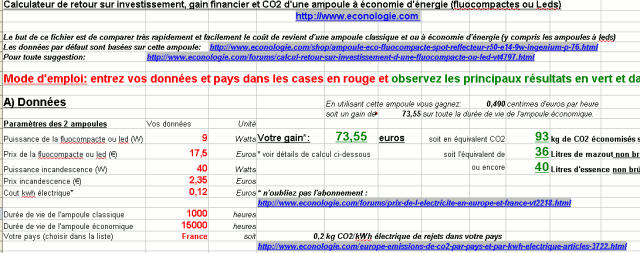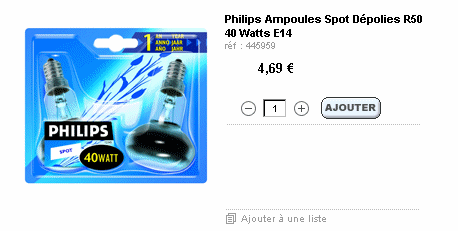Download the calculator here: https://www.econologie.com/calcul-du-ret ... -3659.html

I had fun with a "funny" calculation: The financial benefit of investing a compact fluorescent bulb to replace a conventional light bulb
To simplify (a little you will see that it is already quite complicated) I took these assumptions:
- the bulb turns 24h / 24h short continuously
- lifetime of 15 000h (nothing prevents it to exceed this lifetime)
- the electric kWh costs 0.1 € TTC (subscription included ca can be even a little more expensive but let's go)
- calculation based on thespotlight bulb E14 R50
- the bulb costs 17.50 € TTC
- a classic replacement bulb costs about 2.35 € TTC and has a life of 1000h.
Example (2nd google link on "R50 bulb" for the curious :)):

A) Gains on bulb changes (cost of equipment only):
- Assuming that on average the constructor data is just: 15 000 h = 15 x 1000h (if yes!)
- Gains on the change of the material: 15 * 2.35 - 17.50 = 17.75 €
- Cost per hour of operation of the classic: 2.35 € / 1000 = 0,00235 € / h = 0,235 cents € per hour.
- Cost per hour of operation of the fluo on the cost of the material: 17.50 € / 15 000 = 0,001167 € / h is 0,1167 cents € per hour.
We see that the cost of purchase compared to the operating hours of a conventional light bulb is already more than 2 times more expensive than that of a compact fluorescent and this without taking into account the energy saving (and the cost of changing bulbs: transport, time spent doing other
thing...).
So those who think fluorescent bulbs are too expensive just learn to calculate :)
Now calculate the energy gain!
B) Gain on saved energy
- Already the calculation is done in comparison with a conventional bulb of 40W while the fluo given in example will produce the equivalent of 50W (I did not find a classic R50 in 50W!). It does not matter so we will take 40W equivalent since if I have trouble finding a 50W R50 consumers also probably!
- Every h of operation we gain so 40 - 9 = 31 W equivalent
- On 15 000h it is therefore: 31 * 15 = 465 kWh
- In €: 465 * 0.1 = 46.50 € saved on 15 000h
- Energy cost per hour of the classic: 40 / 1000 * 0,1 = 0,004 € / h is 0,4 cents € per hour.
- Energy cost per h of fluo: 9 / 1000 * 0,1 = 0.0009 € / h is 0,09 cents € per hour.
It is interesting that the operating cost per hour (or energy) is respectively for the classic 0,4 / 0,235 = 1,7 and for the fluo 0,09 / 0,1167 = 0,77 times higher than the investment cost.
C) Cumulative gains and return on investment
To summarize, we have:
- for the classic: 0,235 + 0,4 = 0,635 cents € per hour of operation.
- for the fluo: 0,1167 + 0,09 = 0,207 cents € per hour of operation.
How much time to make profitable the fluocompacte = supplement of fluo / Gain per hour is in our case (the * 100 is because the hourly cost is in centime):
(17,50 - 2,35) * 100 / (0,635 - 0,207) = 3540 h.
It is therefore necessary 3500 h to make profitable this model in replacement of a classic model of 40W. If the bulb cremates before you lose money! So be sure not to buy low-end bulbs even if their cost seems alien. Indeed a neon bulb of the same characteristics to 10 € (assuming it exists) still 1700h to be profitable! Now nobody is immune to a network disruption and an unlucky flash of lightning (which should theoretically be supported by EDF but we can still dream).
Now (sorry for the length but it's important) let's see the most "interesting": the financial profitability linked to the investment of this compact fluorescent!
D) Financial profitability of a neon bulb
- We have just seen: the hourly gain of a compact fluorescent in operation is 0,635 - 0,207 cents € per hour is 0,428 cents € per hour.
- Number of hours in the year: 24 * 365,25 = 8766 h
- By turning 24 / 24 the bulb would make you win: 8766 * 0,428 / 100 = 37.50 € the 1ere year.
- Lifetime 15 000 h is 1,71 year. The bulb, in theory, does not take 2 years.
- The 2ieme year it remains so: 15000-8766 = 6234 h. That is a gain of 26,68 €.
Taking into account the initial investment of 17.50 € we therefore have a "virtual" financial return of: (37,50 + 17,50) / 17,50 = 314% per year.
The 2nd year we get, more "modestly": (37,50 + 17,50 + 26,68) / (37,50 + 17,50) = 48,5% annually
In the end, the return on the 15 000h is: (17,50 + 37,50 + 26,68) / 17,50 = 466% on less than 21 months.
Remarks and limits of reasoning
- some will laugh saying that it is ridiculous sums on a light bulb it is true: but what about the millards that can be changed in the world to see in France?
- some will laugh by saying that it is virtual and that it does not really allow you to earn money in your bank account. Certainly but to these people, surely too close to their money (or their banker or both), I say to go back to school to relearn the definition of an "economy".
- These calculations are valid only if the lifespan of the bulbs given by the manufacturer are realistic, but, statistically, there is as much chance that an incandescent bulb burns prematurely a neon bulb. No?
- Fluorescent bulbs 1ere price can never be profitable
- before placing your money in the bank at low rates think about this kind of small investment ...and yes buy better it can be an investment!
I stop there I think that few of you will read until the end ...



